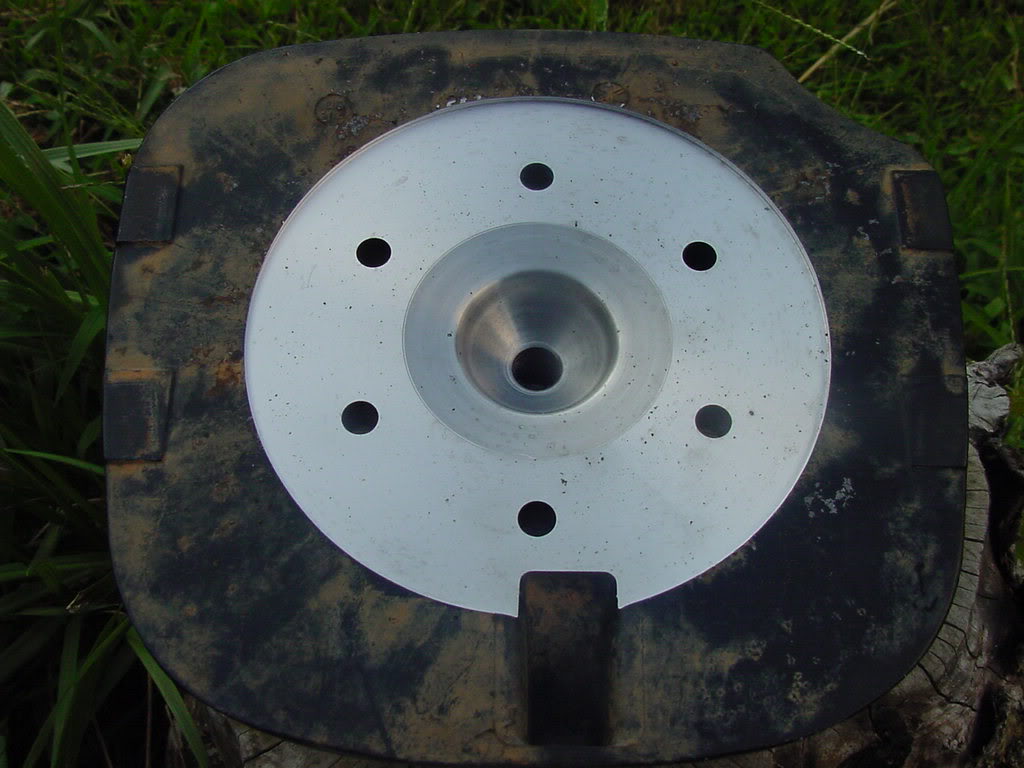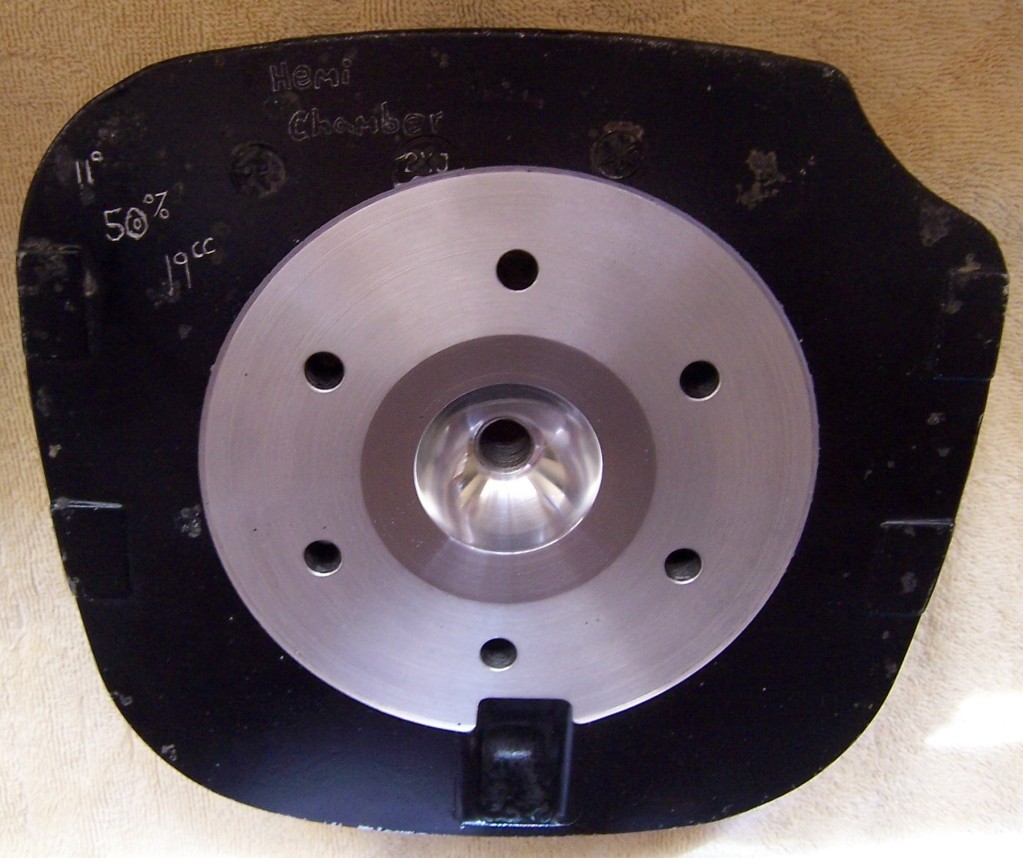It's not a secret that the stock Yamaha Blaster head design is...... crap. There is a LOT of room for improvement and this thread will delve into some of the knowledge needed to improve (or at least, for those who don't have the capacity to cut one themselves), understand head parameters.
First, this is in addition to the information included in "squish, mystery or not" thread. You'll need to cover some of that ground first to understand how squish in particular affects the other parameters and why the other parameters change the needed squish.
Glossary:
Squish or quench area or band: The area between the outside edge of the combustion chamber and the hemispherical (or torrodial) area in the center of the head.
Squish gap/clearance: The distance between the squish area and the piston crown at TDC.
Combustion chamber: The area inside the head that the flame and fire contact. Usually consists of two general areas, the squish or quench area and the chamber proper.
Squish percentage: The percentage of the total bore area that is taken up by the squish band and "break" area.
Break area: The small amount of material that is used as a transition area from the squish area to the combustion chamber.
UCCR (UnCorrected Compression Ratio): The mathematical calculation representing the ratio of swept volume to trapped volume in an engine.
Swept volume: The volume that the moving piston displaces as it travels. Basically, bore x stroke = displacement.
Trapped volume: The area that all of the swept volume is compressed into when the piston reaches TDC
CCR (Corrected Compression Ratio): The mathematical representation of volume above the exhaust port to trapped volume. Usually called the "Japanese method" and only useful for cranking compression comparison on 2 stroke motors!
TDC: Top Dead Center the upmost point that the piston travels, when the crank bearings, crank pin, big end bearing, piston pin bearing, and piston thrust are all aligned "straight up and down". Crucial figure for head tuning as it's needed to figure out squish gap thickness
BDC: Bottom Dead Center. The lowest point that the piston travels to.
Predetonation: The term that refers to when the charge is fired too early. It takes a certain amount of time for the explosion (or more precisely, the pressure wave generated during the explosion) to reach the piston crown. This is the reason the stock ignition timing is "advanced" during higher RPM operation. The time it takes that flame front and pressure wave to hit the piston is constant (relatively) but the piston speed and dwell time is more and more limited as rpm's rise. Predetonation can occur due to either too much ignition timing (controlled predetonation that can be adjusted out) or by other factors present in the engine (too huch heat, lean condition, "hot spots")
Dwell: In modern engines, the amount of time and position of the piston while the connecting rod is rolling over and under TDC and BDC. The piston also changes face thrust at this position. In a well worn cylinder, there is a "groove" at the top and bottom of the cylinders where the rings rub the cylinder at the dwell points. This is the area with the most amount of wear in a "normal" engine.
Squish velocity: The speed of the homogenized charge (air:fuel mixture) as the piston rises and "pushes" the charge towards the center of the combustion chamber. Pushing the charge too fast (high velocity) will preheat the charge to the point of autoignition resulting in predetonation. Piston speed affects this number GREATLY.
Piston speed: The rate at which a piston rises and falls for a given crankshaft RPM. Usually expressed as feet/second. More rpm = greatly increased piston speed.
Overstuffing: The rate at which volumetric efficiency rises well beyond "normal" capacity as the engine, pipe, carb, portwork, and head begin to work together.
Volumetric Efficiency: The ratio of the engine's ability to move old charge out and new charge in under real world conditions versus the "theoretical" ability at no engine rpm. Generally given as a percentage that gradually drops as engine rpm increases.
First, this is in addition to the information included in "squish, mystery or not" thread. You'll need to cover some of that ground first to understand how squish in particular affects the other parameters and why the other parameters change the needed squish.
Glossary:
Squish or quench area or band: The area between the outside edge of the combustion chamber and the hemispherical (or torrodial) area in the center of the head.
Squish gap/clearance: The distance between the squish area and the piston crown at TDC.
Combustion chamber: The area inside the head that the flame and fire contact. Usually consists of two general areas, the squish or quench area and the chamber proper.
Squish percentage: The percentage of the total bore area that is taken up by the squish band and "break" area.
Break area: The small amount of material that is used as a transition area from the squish area to the combustion chamber.
UCCR (UnCorrected Compression Ratio): The mathematical calculation representing the ratio of swept volume to trapped volume in an engine.
Swept volume: The volume that the moving piston displaces as it travels. Basically, bore x stroke = displacement.
Trapped volume: The area that all of the swept volume is compressed into when the piston reaches TDC
CCR (Corrected Compression Ratio): The mathematical representation of volume above the exhaust port to trapped volume. Usually called the "Japanese method" and only useful for cranking compression comparison on 2 stroke motors!
TDC: Top Dead Center the upmost point that the piston travels, when the crank bearings, crank pin, big end bearing, piston pin bearing, and piston thrust are all aligned "straight up and down". Crucial figure for head tuning as it's needed to figure out squish gap thickness
BDC: Bottom Dead Center. The lowest point that the piston travels to.
Predetonation: The term that refers to when the charge is fired too early. It takes a certain amount of time for the explosion (or more precisely, the pressure wave generated during the explosion) to reach the piston crown. This is the reason the stock ignition timing is "advanced" during higher RPM operation. The time it takes that flame front and pressure wave to hit the piston is constant (relatively) but the piston speed and dwell time is more and more limited as rpm's rise. Predetonation can occur due to either too much ignition timing (controlled predetonation that can be adjusted out) or by other factors present in the engine (too huch heat, lean condition, "hot spots")
Dwell: In modern engines, the amount of time and position of the piston while the connecting rod is rolling over and under TDC and BDC. The piston also changes face thrust at this position. In a well worn cylinder, there is a "groove" at the top and bottom of the cylinders where the rings rub the cylinder at the dwell points. This is the area with the most amount of wear in a "normal" engine.
Squish velocity: The speed of the homogenized charge (air:fuel mixture) as the piston rises and "pushes" the charge towards the center of the combustion chamber. Pushing the charge too fast (high velocity) will preheat the charge to the point of autoignition resulting in predetonation. Piston speed affects this number GREATLY.
Piston speed: The rate at which a piston rises and falls for a given crankshaft RPM. Usually expressed as feet/second. More rpm = greatly increased piston speed.
Overstuffing: The rate at which volumetric efficiency rises well beyond "normal" capacity as the engine, pipe, carb, portwork, and head begin to work together.
Volumetric Efficiency: The ratio of the engine's ability to move old charge out and new charge in under real world conditions versus the "theoretical" ability at no engine rpm. Generally given as a percentage that gradually drops as engine rpm increases.
Last edited:



